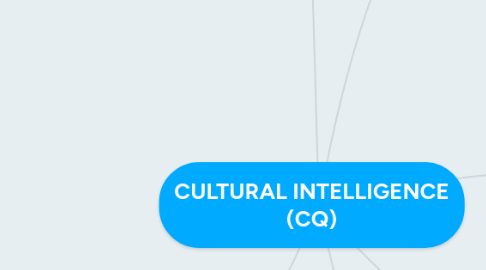
1. CQ Action (Behavior)
1.1. Capability of flexing behaviors to be culturally appropriate
1.2. 3 Components
1.2.1. Speech Acts
1.2.1.1. 4 Major Types of Speech Acts
1.2.1.1.1. Making Requests and Demands
1.2.1.1.2. Turning Down a Request
1.2.1.1.3. Receiving Compliments
1.2.1.1.4. Giving Negative Feedback
1.2.1.2. Direct VS Indirect
1.2.1.2.1. Direct: Very straight to the point
1.2.1.2.2. Indirect: Does not go direct to the point
1.2.2. Vocal Behaviors
1.2.2.1. Vocalization
1.2.2.1.1. How voice is produced?
1.2.2.2. Vocal Range
1.2.2.2.1. 4 P's
1.2.2.2.2. Circumplex Model of Emotions
1.2.2.3. Tone
1.2.3. Non-Verbal Behaviors
1.2.3.1. Physical Appearance
1.2.3.2. Facial Expressions
1.2.3.3. Kinesics (Body Movement)
1.2.3.3.1. 3 types of Kinesics
1.2.3.3.2. General Principles
1.2.3.4. Proxemics (Space)
1.2.3.4.1. Interpersonal Space
1.2.3.4.2. Place
1.2.3.4.3. Space
1.2.3.5. Chronemics (Time)
1.2.3.5.1. Clock Time VS Event Time
1.2.3.5.2. Past, Present & Future
1.2.3.5.3. Monochronocity VS Polychronocity
1.2.3.5.4. Pace of Life
1.3. Mehrabian Rule
1.3.1. 55% Body Language
1.3.2. 38% Tone
1.3.3. 7% Words
1.4. Self-Presentation Theory
1.4.1. Being aware of behaving appropriately for the situation
1.5. Impression Monitoring
1.5.1. What is considered a positive behavior in one culture might be a negative behavior in another
1.5.2. 4 Levels of of Impression Awareness
1.5.2.1. Level 1: "Impression Oblivion"
1.5.2.1.1. Completely unaware that people are forming impressions of him/her and how he/she is coming across to them
1.5.2.2. Level 2: "Unconscious Impression Scanning"
1.5.2.2.1. Unconsciously monitors the impression of others, but not really aware of it
1.5.2.3. Level 3: "Impression Awareness"
1.5.2.3.1. Knows that others are actively forming impressions of him/her, and thinks about what kinds of impressions they are making
1.5.2.4. Level 4: "Impression Focus"
1.5.2.4.1. Too fixated on what other people are thinking of him/her
1.5.2.4.2. Ineffective in interaction
1.5.3. Not overly concerned with the impression you are making
2. Four Factor-Model
2.1. CQ Drive (Motivation)
2.1.1. CARE Model
2.1.1.1. Curiousity
2.1.1.1.1. Hunger to learn more of something that are not familiar
2.1.1.2. Awe
2.1.1.2.1. Sense of wonder and "WOW"
2.1.1.3. Respect
2.1.1.3.1. Accepting ways of a person doing something, because you've learnt that there is a reason, a rule of some sorts behind his/her actions
2.1.1.4. Engagement
2.1.1.4.1. Want to approach a person and make friend with him/her.
2.1.2. Amount of energy for crossing cultures
2.2. CQ Knowledge (Cognition)
2.2.1. Level of understanding of how cultures are similar or different
2.2.2. Iceberg Analogy of Culture
2.2.2.1. Objective Culture (above water)
2.2.2.1.1. VISIBLE aspect of of culture
2.2.2.1.2. Obvious and explicit
2.2.2.1.3. 10 Buckets of Objective Culture
2.2.2.2. Subjective Culture (below water)
2.2.2.2.1. INVISIBLE aspect of culture
2.2.2.2.2. Less concrete, less obvious and less explicit
2.2.2.2.3. 6 Major Cultural Values
2.3. CQ Strategy (Meta-Cognition)
2.3.1. Mental capability to acquire and understand cultural knowledge
2.3.2. Skills of Awareness
2.3.2.1. Antenna = Signals
2.3.2.1.1. Signals within SELF (Internal Signals)
2.3.2.1.2. Signals from outside (External Signals)
2.3.2.2. BEING AWARE
2.3.2.2.1. Keeping Mindful of the PRESENT
2.3.2.2.2. MINDFULNESS
3. Culture
3.1. Set of 'RULES' shared by a group of people
3.1.1. Rules: Tells us what to do and what not to do
3.1.2. A group of people must understand and play by the same rules
3.2. Is NOT...
3.2.1. Personality
3.2.2. Ecology: How we interact with nature
4. Wheel of Culture
4.1. Religion
4.2. Ethnicity
4.3. Disabilities
4.4. Social Economic Status
4.5. Organisation
4.6. Professionals
4.7. Nationality
4.8. Age
4.9. Family
4.10. Gender
5. Intelligence
5.1. Does not = to IQ
5.2. Is the capability to adapt effectively to the environment
5.2.1. Capability = potential that a person has
5.3. Resides in 3 different parts, or loci, of the person
5.3.1. Intelligence is Biology
5.3.1.1. Brain is the key organ
5.3.2. Intelligence is Cognition
5.3.2.1. Knowledge (Cognition)
5.3.2.2. Strategies (Meta-Cognition)
5.3.2.3. Motivation (Mental Energy)
5.3.3. Intelligence in Behavior
5.3.3.1. Person's outward actions and behaviors
5.4. Academic Intelligences
5.4.1. Emphasise reasoning and understanding
5.4.2. Intelligence Quotient (IQ)
5.5. Non-Academic Intelligences
5.5.1. Social Intelligence
5.5.2. Emotional Intelligence
5.5.3. Practical Intelligence

